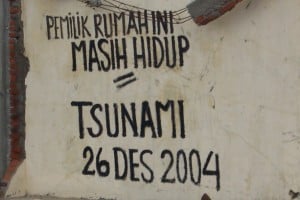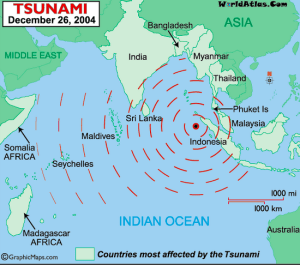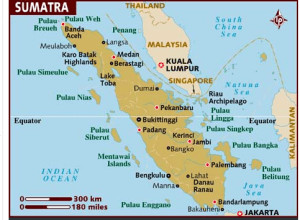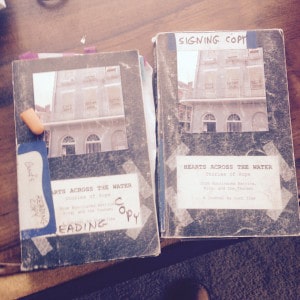
A word from Curt
Over the next month, we’re sharing stories from our 2005 book, Hearts across the Water.
This is my fourth short story collection and is set during the two twin hurricanes that struck Louisiana that year.
Although the majority of the book deals with the hurricanes, the first part recounts my life-changing trip to post-tsunami Indonesia after the deadly earthquake/tsunami.
Come join us on this journey.
It’s a sobering trip.
The Tsunami. We arrive eighty days after the disaster.

Chapter 2 : The Tsunami – December 26, 2004
It was a typical sunny tropical morning along the coast of Sumatra, Indonesia’s northernmost and third largest island.
Being a Muslim nation, the days around Christmas were nothing to be noticed or celebrated, especially here in the Islamic area known as “The Porch of Mecca.”
Even though it was Sunday morning in Sumatra, in America it was still Christmas night.
Thirteen hours behind in the Central time zone found many Louisianans still enjoying a day of eating, opening presents, and being among family.
Back in the Sumatran capital of Banda Aceh it was just before 8:00 am when the first shaking and rumbling began.
Earthquakes are common in this part of the world where a great fault line lies under the mountainous island, which is why many of the most active volcanoes in the world are on this island.
Off the western coast is where two giant plates of the earth’s crust meet.
Due to these geologic features Indonesia has always been a land of earthquakes and volcanic activity.
But the earthquake on the morning of December 26, 2004 was not just any earthquake.
Measured at 9.0 on the Richter scale, it was the fourth largest recorded quake since 1900.
Most earthquakes last a few seconds, but this one shook for ten minutes.
The entire planet even vibrated a few centimeters back and forth.
The epicenter of this earthquake was in the Indian Ocean, just north of Simeulue Island off the western coast of Northern Sumatra, Indonesia. The center was about 150 miles southwest of Banda Aceh.
This earthquake was the result of the slipping of one of the two great land mass plates under the ocean. This sudden upward surge of a land plate nearly one hundred miles long created a huge amount of seismic energy. This energy lifted up an enormous amount of seawater that began traveling outward as a seismic sea wave, or tsunami.
As the people along the coasts of Indonesia came outside their homes to view the damage caused by the strong tremors, little did they know that within minutes, a much deadlier force was moving toward them — A killer tsunami wave.

Chapter 3 : Simeulue Island
The small Indonesian island of Simeulue (Pronounced Sim-ah-LOO) sits about 150 miles off the coast of Sumatra surrounded by the Indian Ocean.
It was the closest land to the great earthquake on the morning of December 26.
Despite its proximity to the earthquake and subsequent tsunami waves, surprisingly only seven people died that morning.
The minimal loss of life there, and the reason for it, is an amazing story.
But first I must tell a much sadder story from the nearby coast of Sumatra.
Lampuuk (pronounced Lom-Pook) is a coastal village on the western shore of Sumatra.
On the morning of December 26 it was the home of about 10,000 people.
The village sits in a valley between two small mountain ranges. Thirty kilometers through this valley is the large seaport capital of Banda Aceh.
Because of its ocean setting, Lampuuk is a village of fishermen. The aqua-colored Indian Ocean is the source of life and labor for the village. Many of the fishermen were already on the ocean on the morning when the earthquake occurred.
That morning, the residents of Lampuuk ran outside during the first tremors of the earthquake.
They knew it was safer outside and everyone wanted to see what was occurring.
Within a few minutes of the tremors, shouting started down near the beach.
Word quickly spread that the sea had receded a long way back exposing a large area that had been underwater a few seconds earlier.
The excited shouting told that flopping fish were everywhere on the newly uncovered beach areas.
Villagers, especially children, ran hurriedly to catch the fish. They grabbed buckets, nets, and even plastic bags. It was a field day of squirming fish and laughing children. The women of Lampuuk followed their children down to the beach. Anxiety showed on their faces as they wondered about their fishermen husbands out on the strangely behaving ocean.
Men who were still on the sea after the earthquake felt the first wave come under their boats. These tsunami waves were traveling over 500 miles per hour out on the open sea. The waves were only a few feet high as they went past the boats. As the first wave began nearing land it slowed down considerably.
However, the sloping continental shelf caused the wave to stack up on itself similar to what happens with a hurricane storm surge.
In the village of Lampuuk and along its beaches, everyone was unaware of the coming tragedy. A field day of fish-catching was soon to become a killing field on this beach.
Everyone was unaware except for one woman.
This woman was not a Lampuuk native. She had grown up on the nearby island of Simeulue.
The strong quake coupled with the shouts about the water receding caused a jolt in her memory.
As a girl she’d heard the oral history of a great tsunami of 1907 on Simeulue in which thousands died.
Older family members had told her that an earthquake followed by the ocean’s receding were the ominous signs of an incoming tsunami.
This woman grabbed her children and ran screaming in the streets of Lampuuk of the coming tsunami.
Even her husband, a Lampuuk policeman, ignored her pleading and screaming as he went toward the beach. This woman’s anguished warnings were ignored by all that morning.
As you can guess, the same cries were going out throughout the coastal areas of Simeulue Island.
By the time the tsunami arrived there, the coastal areas had been evacuated to the nearby higher ground.
That is why only seven people died there that same morning.
The story of Lampuuk, sadly, is much different.
As one of the few survivors said, “When our water buffaloes broke loose and ran inland, we should’ve noticed and followed them.”
Tomorrow’s blog: What I saw at Lampuuk.

You can get your copy of Hearts across the Water in print or as an ebook at www.amazon.com
- If you’ve enjoyed this story, please share it with your friends. The social media buttons make it easy to get the word out.
- If you’ve previously read Hearts, please write an Amazon review.
- If you’d like your own copy of Hearts across the Water, you can order:
- You can get your copy of Hearts across the Water in print or as an ebook at amazon.com
- Ebook Go to Amazon
- Print Copy Go to Amazon
- Autographed copy: Order through our website creekbank.net or by regular mail:
- Creekbank Stories
- 5720 North Drive
- Alexandria, LA 70301
- Include your check for $20 (this includes shipping) and desired autograph inscription.

Post Contact Form
This goes at the bottom of some posts
 Creekbank Stories Curt Iles, Storyteller
Creekbank Stories Curt Iles, Storyteller
